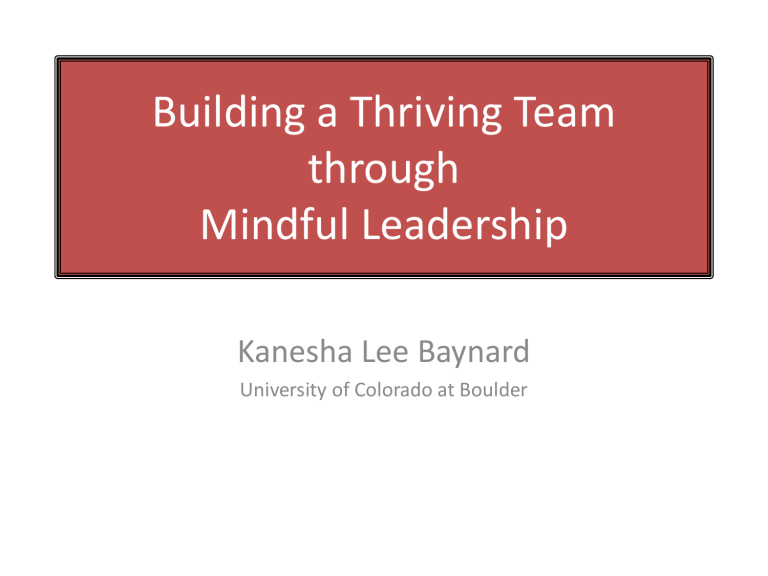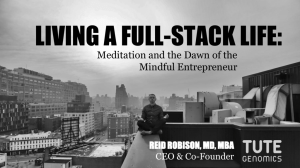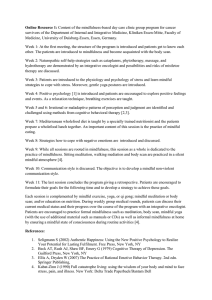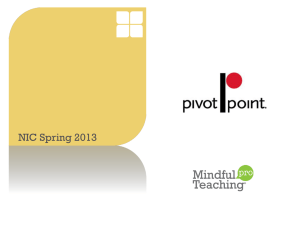Mindful Leadership - Academic Management Institute

Building a Thriving Team through
Mindful Leadership
Kanesha Lee Baynard
University of Colorado at Boulder
Goals of this talk
Overview of mindful leadership
Authentic leadership vs. charismatic leadership
Initial ideas and tools for:
developing your mindful leadership skills
creating a productive and satisfying relationship with your team (or potential team)
Expand your thinking about colleagues and staff as important members of your team
Share thoughts and ideas
Charismatic leadership
High intelligence (IQ) and low emotional intelligence (EQ)
Lacks an awareness of self and this feeds into actions
No deep understanding of motivations
Past fears and failures have not been examined
Distracted by the desire to achieve success and recognition – in the eyes of others
Authentic leadership
Genuine intentions
Understanding of the purpose of leadership
Building trustworthy relationships
Operating with high levels of personal discipline
Intelligence and a high level of emotional intelligence
Self-awareness
-Bill George
What comes to mind when you hear
Mindful Leadership ?
Developing mindfulness
Mindfulness – the awareness of one’s mental processes
Understanding of how one’s mind works
Leaders are able to address challenges and adversity in a non-threatening way
Integrating selfawareness with actual experience in leading challenging situations
Gaining awareness through feedback and group (team) support
Mindfulness enables leaders to be fully present, aware of themselves and their impact on other people, and sensitive to their reactions to stressful situations.
-Bill George
Mindfulness
practice of living in the present moment
Leadership
doing the right thing
( management is doing things right )
bringing one’s complete attention to the present experience on a moment-tomoment basis
guide a team through change and applies emotional intelligence in a way that attains the best work out of the team
paying attention in a particular way: on purpose, in the present moment, and nonjudgmentally
inspires and motivates a team to drive themselves
-Jon Kabat-Zinn -Coach4Growth
Leaders who are mindful tend to be more effective in understanding and relating to others, and motivating them toward shared goals.
Hence, they become more effective in leadership roles.
–Bill George
How is your team organized?
How often do you think about this?
Do you think about an org chart?
Do you think about a team web?
Today, each time you speak, check to see if your words match your best self. If not, rephrase-or be silent.
-Martha Beck
Mindful: referring to the simple act of noticing new things
Enables team to be mindful as well
Noticing puts the team in the present, makes the team sensitive to context, and aware of change and uncertainty
-Ellen Langer
People buy into the leader before they buy into the vision.
–John C. Maxwell
How do you…at work?
•
Manage stress
•
Remain objective and less reactive
•
Show compassion to yourself and others
•
Build trust
The manager asks how and when; the leader asks what and why. - Warren G. Bennis
Mindfulness and Self-awareness
Knowing yourself enables you to make choices about how you respond to people and situations.
Deep knowledge about yourself enables you to be consistent, to present yourself authentically, as you are.
We trust—and follow—people who are real, who are consistent, whose behavior, values, and beliefs are aligned.
We trust people whom we do not constantly have to second-guess.
Richard Boyatzis and Annie McKee
The very essence of leadership is that you have to have vision. You can't blow an uncertain trumpet.
-Theodore M. Hesburgh
Think about the current climate in your work place
Mindful leadership would fit because:
Mindful leadership could be a challenge because:
Once you truly intend to accomplish something, the success you can achieve is greater than you can imagine.
-Martha Beck
The process of opening up can make us feel vulnerable, even afraid.
Many leaders simply shut down in order to avoid this kind of uneasiness.
It takes confidence and optimism to let go of preconceived notions while also studiously opening oneself to new information and solutions.
Many also shut down to prove to people around them that they are decisive and know what to do (even when they do not).
Avoiding openness—and vulnerability—results in a narrow focus and can ultimately cause you to slip into mindlessness.
Harvard Business School Press, from Resonant Leadership: Renewing Yourself and Connecting with Others Through Mindfulness, Hope and Compassion.
Any advice that doesn't feel liberating is wrong. Ignore it.
-Martha Beck
What leadership resources are currently available to you?
Leadership and learning are indispensable to each other.
-John F. Kennedy
Leadership styles
Social styles/inventories
Emotional intelligence
Strength quest
Myers Briggs
Conflict management style
Real colors
Work/life balance
Mindfulness
Coaching
A good objective of leadership is to help those who are doing poorly to do well and to help those who are doing well to do even better.
-Jim Rohn
Build trust through clarity and consistency.
Know that you will feel uncomfortable, even vulnerable, because in the midst of real change around you, the rules are not clear and politically expedient behavior is very tempting.
Make sure you never profess beliefs when people are watching, only to act differently when the temperature rises and the pressure is on.
-Dan Sontag
Any moment you spend attacking yourself is a moment away from your higher purpose and your power to love. Don't go there.
-Martha Beck
For a leader, each conversation and exchange is an opportunity to gather valuable information about people, groups, and cultures, while building relationships and resonance.
Attending carefully to our human environment and our relationships enables us to see details we may have missed and generate more accurate ideas about what is really going on.
Richard Boyatzis and Annie McKee
You don't owe anyone time or energy simply because they want it. Doing out of obligation isn't kindness; it's self-betrayal.
-Martha Beck
We notice subtle patterns in people's behavior, group dynamics, organizational processes, and even worldwide events.
When we are mindful, we are more in control of ourselves and situations simply because we see reality more clearly.
Richard Boyatzis and Annie McKee
Leaders should be collaborative, modest, and generous – Bill Bradley
Work to capitalize on your strengths.
Improve upon those areas that may be holding you back from achieving your immediate and longterm goals.
Assess your current leadership strengths.
Work to improve your influence skills in the contexts that are most important to you and your team.
Moving toward mindful leadership
Why expect comfort when you step outside your comfort zone? Expect fear and keep moving! Have courage! Soon, what was once out of your comfort zone will be INSIDE of it.
-Valorie Burton
What are two steps you could take towards mindful leadership by Monday?
The key to successful leadership today is influence, not authority.
Ken Blanchard
See the big picture.
Plan what you say.
Start small.
Need to turn things around? Shift your approach.
Rise above the fray.
Stay focused on solutions.
Tap into unofficial networks.
The Coaching Session
-Valorie Burton
If you want real control, drop the illusion of control. Let life live you. It does anyway.
-Byron Katie
See the big picture.
① Influence is knowing what you want.
② It’s more important to know what others want.
③ If you know what others want and focus on helping them get it, they are far more likely to help you towards your goals.
④ Understand your institutions goals - not just your department's goals.
⑤ See the big picture and where you fit into it.
Rise above the fray.
① Being aware of of the big picture, will most likely keep you from getting get pulled into workplace negativity.
② Choose your battles wisely.
③ Ask yourself, "Will this situation matter a month or year from now?"
④ If the answer is "no," let it go.
You can transform any situation by bombarding it with compassion. Make sure you include yourself, and you can always do this.
-Martha Beck
Stay focused on solutions.
① Many people focus on problems. You want to focus on solutions.
② Every problem presents an opportunity for you to demonstrate your problem-solving skills.
③ When problems arise, don't go to your team until you've answered the question, "What are three potential solutions?"
Tap into unofficial networks.
① Every institution has unofficial circles of influence.
② Tune in and notice who the influencers are.
③ Build trust and reciprocal relationships with them.
④ Be interested in what matters to them.
Management is doing things right; leadership is doing the right things.
-Peter F. Drucker
Start small.
① Make it easy to say "yes" by finding small things you want to influence.
② Getting a decision maker to say "yes" once makes it easier for them to say "yes" again.
③ Build trust by starting small. Expand your influence from there.
Plan what you say.
① Influencers are strategic.
② When it's time to ask for something, spend some time - even if just have a minute or two - planning how to ask.
a) When is a good time?
b) What groundwork do I need to lay?
c) What is the best way to phrase what I have to say so the other person will feel positive about saying "yes"?
Everything is happening in new ways. The only preparation is being open and relaxed. Do that, and all will be well.
-Martha Beck
What are two additional steps you could take towards mindful leadership by Monday?
Without initiative, leaders are simply workers in leadership positions.
-Bo Bennett
Key questions
Do I know what is expected of me at work?
Do I have the materials and equipment I need to do my work right?
At work, do I have the opportunity to do what I do best every day?
In the last seven days, have I received recognition or praise for good work?
Does my supervisor, or someone at work, seem to care about me as a person?
Is there someone at work who encourages my development?
Your next step is always apparent: It's the most obvious thing that will bring you joy, always some sort of rest or play.
-Martha Beck
Additional questions
At work, do my opinions seem to count?
Does the mission of my company make me feel like my work is important?
Are my co-workers committed to doing quality work?
In the last six months, have I talked with someone about my progress?
At work, have I had opportunities to learn and grow?
Competence goes beyond words. It's the leader's ability to say it, plan it, and do it in such a way that others know that you know how and know that they want to follow you.
– John C. Maxwell
If organizations were mindful — referring to the simple act of noticing new things — leadership would be quite a different matter.
They would not only be mindful themselves; their most important responsibility would be to enable their followers to be mindful as well.
One might argue that in an increasingly complex world — where work cuts across all types of institutional boundaries — the leader's only task may be to promote and harness
"distributed" mindfulness.
-Ellen Langer
Sources and Resources
• Why Not You? 28-Days to
Authentic Confidence
– Valorie Burton
• “Leadership’s Lost
Decade” (appeared in wallstreetjournal.com,
February 3, 2010)
– Bill George • Finding Your Own North
Star: Claiming the Life You
Were Meant to Live
– Martha Beck
• Emotional Intelligence
– Daniel Goleman
• How Did I Get So Busy?
General Edition
– Valorie Burton
• Mindful Leadership: A
Brain-Based Framework
– Michael H. Dickmann
Sources and Resources
• ASAE & The Center for Association Leadership
– http://www.asaecenter.org/main/
• Coping with Toxic Managers, Subordinates ... and Other Difficult People: Using Emotional
Intelligence to Survive and Prosper
– Roy H. Lubit
• First, Break All The Rules: What The World’s
Greatest Managers Do Differently
– Marcus Buckingham and Curt Coffman
• The Girl's Guide to Being a Boss (Without Being a Bitch): Valuable Lessons, Smart Suggestions, and True Stories for Succeeding as the Chick-in-
Charge
– Caitlin Friedman and Kimberly Yorio
• Harvard Business Review Magazine
• How to Say It For Women: Communicating with
Confidence and Power Using the Language of
Success
– Phyllis Mindell
• International Association of Administrative
Professionals
– http://www.iaap-hq.org
• Now, Discover Your Strengths
– Marcus Buckingham and Donald O. Clifton
• Strengths-Based Leadership
– Tom Rath and Barry Conchie
• StrengthsFinder 2.0: A New and Upgraded
Edition of the Online Test from Gallup's Now,
Discover Your Strengths
– Tom Rath
• Working With You is Killing Me: Freeing Yourself from Emotional Traps at Work
– Katherine Crowley and Kathi Elster
Kanesha Lee Baynard
Kanesha.Baynard@colorado.edu
303.492.2590
Educator Blogger Life and Leadership Coach www.itsafullnest.com
MultigenerationalNests





